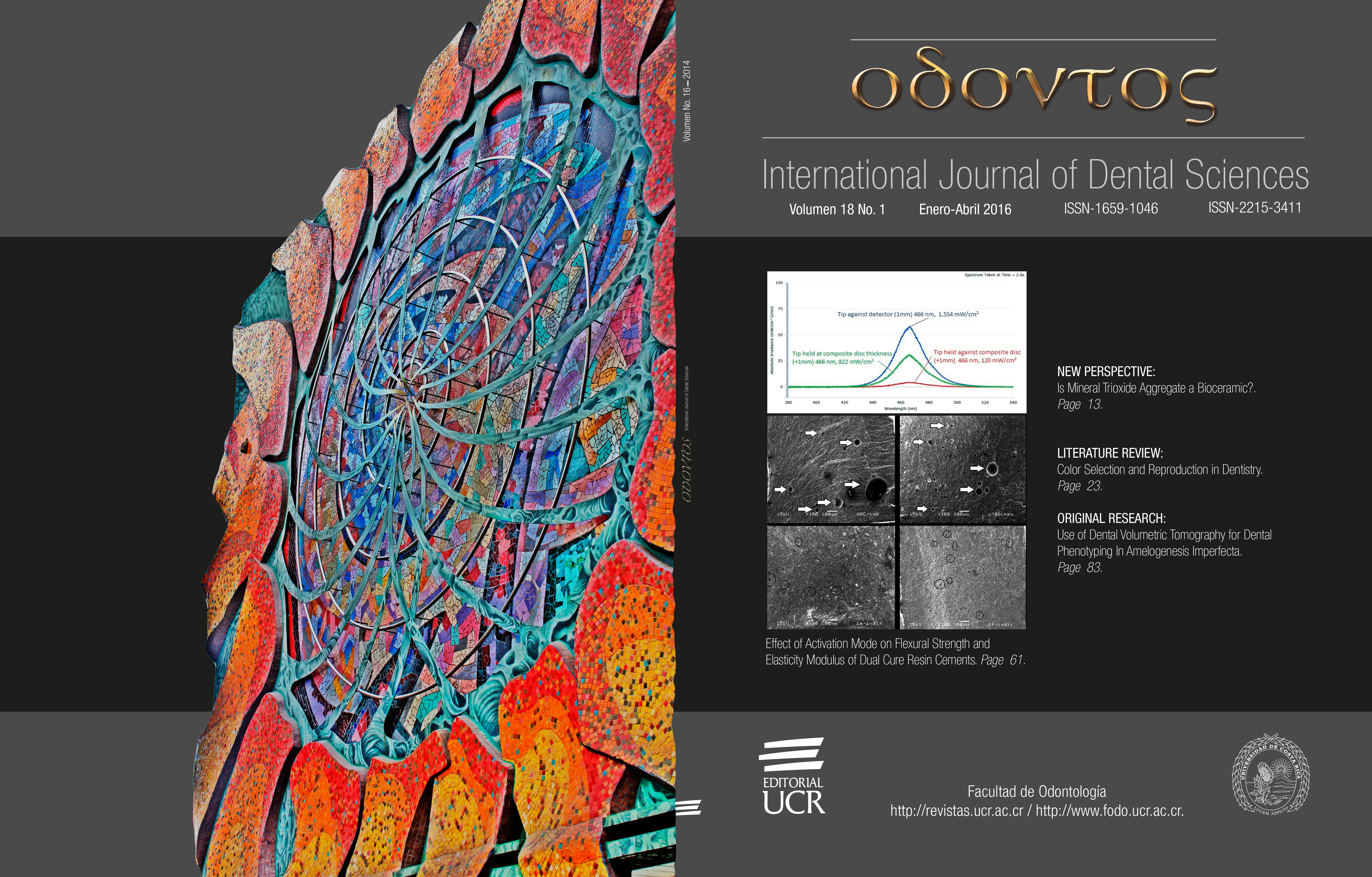Resumen
Amelogenesis imperfecta (AI) describes often severe, largely Mendelian biomineralisation defects of tooth enamel. AI enamel can be abnormally thin, soft, fragile, pitted and/or badly discoloured, resulting in major morbidity as patients have difficulty maintaining oral hygiene, experience low self-esteem due to poor aesthetics and report an inferior quality-of-life. Improved understanding of biomineralisation defects in AI would assist in clinical management of AI patients. Dental Volumetric Tomography (DVT, commonly known as Cone Beam CT scanning) is a diagnostic X ray based methodology that produces three -dimensional anatomical images of the skeletal tissues (including the teeth). The aim of this study was to investigate the use of DVT to provide detailed dental anatomy associated with AI. A Morita Veraviewpocs 3D R 100 was used to generate high definition 3D digital images of the maxillae of eight AI-affected volunteers (ethics approval N 440–B2-334 U.C.R.). Pulpal calcifications of varying size, Dens in Vaginitus, dental cysts, root fractures, retained teeth and anomalies in the position of the mandibular canal were all common findings. The data also revealed enamel surface irregularities in an unerupted tooth. In conclusion, use of DVT in AI would facilitate phenotyping by providing identification of dental/oral defects with greater accuracy and definition compared with conventional panoramic radiographs. The data could also be used to aid diagnostics, e.g. by permitting discrimination between hypoplastic enamel (diminished enamel volume) and hypomineralized enamel (failure of normal biomineralization). However, given the high costs associated with DVT and the radiation risks for individual patients, it is best indicated as a research tool for academic and clinical research proposes.
Citas
Gómez M., Campos A. Histología, Embriología e Ingeniería Tisular Bucodental. 3a ed. Editorial Médica Panamericana; 2009.
Chiego D. Principios de Histología y Embriología Bucal. 4a ed.. Madrid, España Chiego: Elsiever; 2014.
Rohen J., Lutjen-Drecoll E. Embriología Funcional: una perspectiva desde la biología del desarrollo. Buenos Aires, Argentina. Editorial Médica Panamericana; 2002.
Mursuli M., Rodriguez H., Landa L. Hernández M. Anomalias Dentales. Revisión bibliográfica. Facultad de Ciencias Médicas. Gaceta Médica Espirituana; 2006. 5.
Calero J. A., Soto L. Amelogénesis Imperfecta. Informe de tres casos en una familia en Cali, Colombia. ColombMed 2005; 36(3):47-50.
Barbería E. Odontopediatría. 2a ed. MASSON; 2002.
Seymen F., Lee KE, Tran Lee C.G., Yildirim M., Gencay K., Lee Z. H., Kim Z. H. Exonal Deletion of SLC24A4 Causes Hypomaturation Amelogénesis Imperfecta. J Dent Res 2014; 93(4):366-370.
U.S. National Library of Medicine. Genetics Home Reference, Your Gude to Understanding Genetic Conditions; Mayo 2015 (Consultado el 26 de Sep 2015). Recuperado de: http://ghr.nlm.nih.gov/
Poulter J., Smith C., Murillo G., Silva S., Feather S., Howell M., et al. A distinctive oral phenotype points to FAM20A mutations not identified by Sanger sequencing. Molecular Genetics & Genomic Medicine; 2015; 1-2.
Pousette, G., Dahllöf G. Outcome of restorative treatment in young patients with amelogenesis imperfecta. A cross-sectional, retrospective study. Journal of dentistry 2014 42:1382-1389.
Subramanium P., Mathew S., Sugnani S. N. Dentinogenesis imperfecta- a case report. Jurnal Indian Society Periodontics Prevent Dent 2008; 3:85-87.
Danda N., Subbarayudu G., Chalapathi R. Prosthodontic Rehabilitation of a patient with Dentinogenesis Imperfecta. Indian Journal of Dental Sciences 2011; 4 (4)
Purvaja P., Dipti S. Darshan Sah. Rehabilitation of a patient with Dentinogenesis imperfecta with overdentures-a case report: The journal of Indian prosthodontic society 2003; 3:8-11
Murillo, G. Berrocal, C. Lesiones del esmalte en desarrollo, clasificación en familias costarricenses. Odovtos 2013; 15:46-48.
Wood N., Goaz P. Diagnóstico Diferencial de las Lesiones Orales y Maxilofaciales. 5ª ed. España: Editorial Harcourt Brace; 1998.
J. Morita Mfg. Corporation. Veraviewpocs 3D F40 y R 100 con el innovador 3D Reuleaux FOV. (Consultado el 22 de Agosto 2015); Recuperado de: http://jmoritaeurope.de/root/img/pool/products/dental/diagnostic_and_imaging_equipment/veraviewpocs_3d_r100/veraviewpocs_3d-r100-f40_es.pdf
Bóveda, C. López, J. Clavel, D. Tomografía Volumétrica Digital-TVD. Departamento de Endodoncia, Centro de Especialidades Odontológicas, Caracas. Venezuela; 2012: 2-17.

